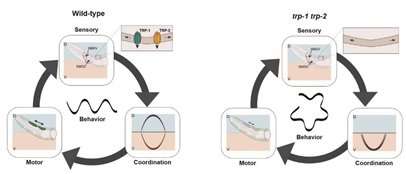Revealing the mechanism behind animals' proprioception

An international team of researcher, led by Professor Kyuhyung Kim from Department of Brain and Cognitive Sciences identified the motor mechanism of the proprioception sense that detects and controls the movement of the body.
Proprioception, often called the "sixth sense" of animals, is a sensory system that detects and controls the position, orientation, and movement of the body. When abnormality occurs in the proprioception sense, body movements become unnatural. In particular, cerebellar hypoplasia patients or degenerative brain disorder patients will suffer from walking difficulties; however, research on the motor mechanism of proprioception sense or related genes is still in the early stages.
Professor Kim's research team has been conducting research to identify the mechanism of proprioception sense that comprehensively detects and controls the entire body movement of animals by using C. elegans, which have a relatively simple nervous system structure and function, as an experimental animal model.
The researchers detected the entire body movement of C. elegans, and by employing mutant screening methods, they discovered the genes TRP-1 and TRP-2, which enable smooth, balanced body movements.
While wild-type C. elegans move straight, the mutant C. elegans that lost the two genes, TRP-1 and TRP-2, showed an abnormal expression pattern by moving only to the left instead of going straight. This abnormal expression pattern reveled that TRP-1 and TRP-2 genes act as driving wheels to help C. elegans move in a straight line.

The gene TRPgamma from the fruit fly, which is similar to TRP-1 and TRP-2, was injected into the mutant C. elegans. As a result, it was observed that normal movement of the mutant C. elegans was restored. This suggests that the TRP-1 and TRP-2 genes are proprioception sense receptors and that their functions are preserved in an evolutionary fashion, even in higher animals, including fruit flies.
In a world-first, the research team also discovered that TRP-1 and TRP-2 are proprioception sense receptors that detect and control the movement of muscles. In addition, when TRP-1 and TRP-2 are artificially revealed in the olfactory nerve of C. elegans, it was observed that the olfactory nerve, which has nothing to do with movement, could detect motion; thus, their study found that TRP-1 and TRP-2 are proprioception sense receptors that control neural activity.
Professor Kim said, "Although the cerebellum is known to control the various movements of animals including walking, the motor mechanism, which detects the movements of each muscle and joint and that induce smooth and balanced movements, has not yet been known. By identifying TRP-1 and TRP-2 genes as proprioception sense receptors that detect and control movements, we expect to provide a clue to study the discovery of genes that cause walking disorders and the development of treatments."
More information: Jihye Yeon et al, A sensory-motor neuron type mediates proprioceptive coordination of steering in C. elegans via two TRPC channels, PLOS Biology (2018).
Journal information: PLoS Biology
Provided by DGIST (Daegu Gyeongbuk Institute of Science and Technology)













